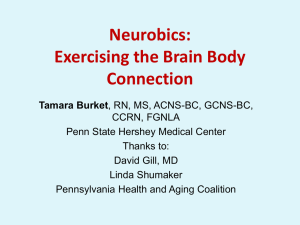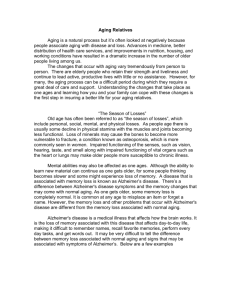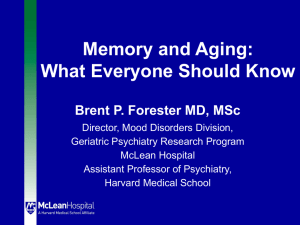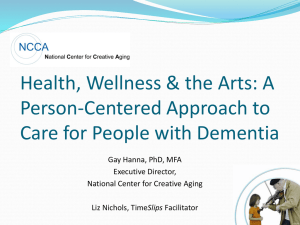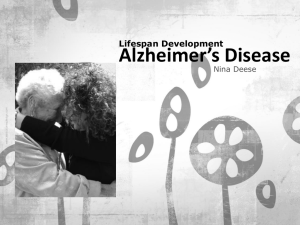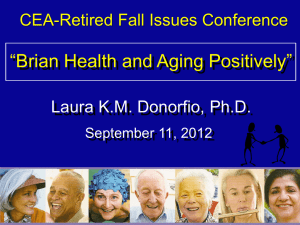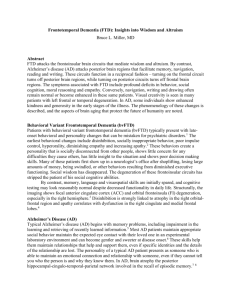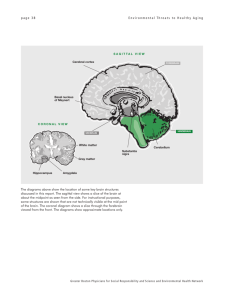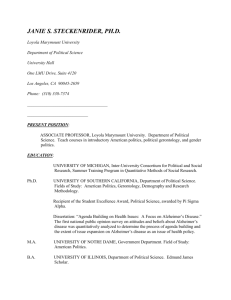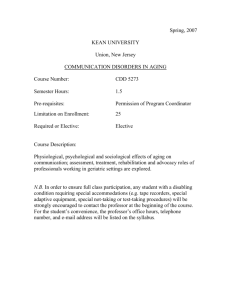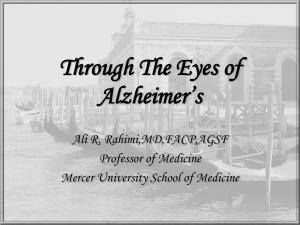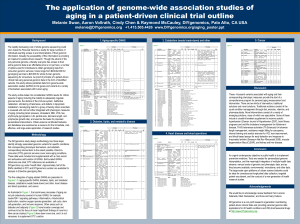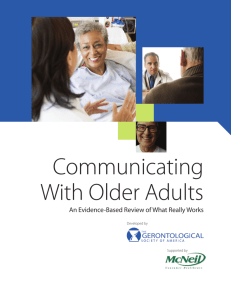to view Dr. Rita Balice-Gordon`s 37
advertisement
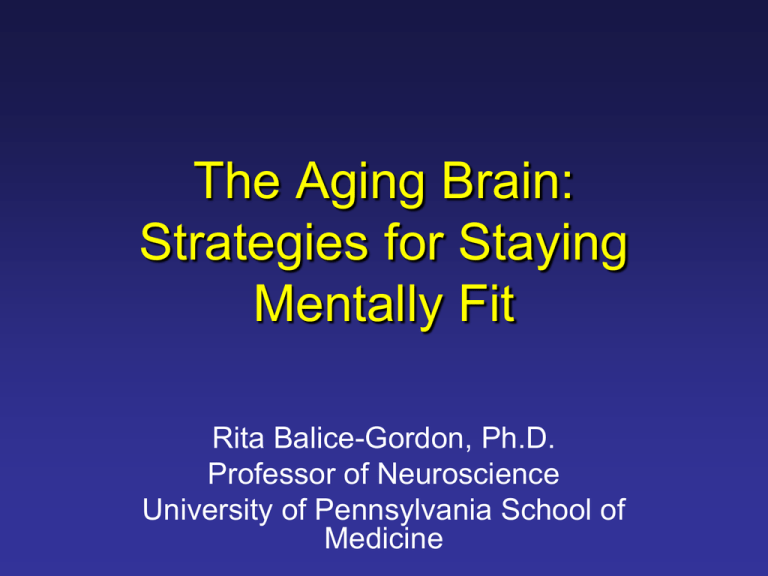
The Aging Brain: Strategies for Staying Mentally Fit Rita Balice-Gordon, Ph.D. Professor of Neuroscience University of Pennsylvania School of Medicine Today’s talk • Brain structure and function • Normal aging vs. diseases of aging • What we can do about it Brain vital statistics • Adult weight: ~ 3 pounds • Adult size: ~ a medium cauliflower Different brain parts have different functions • Divided into right and left halves • Left half controls movement on body’s right side • Language area is mainly on left Brain components: Neurons, Glia, Synapses • The brain has billions of neurons, each with an axon and many dendrites. • Number of neurons: 100,000,000,000 (100 billion) • Neurons communicate via synapses • Number of synapses: 100,000,000,000,000 (100 trillion) • To stay healthy, neurons and glia must communicate with each other, carry out metabolism, and repair themselves. Today’s talk • Brain structure and function • Normal aging vs. diseases of aging • What we can do about it Normal brain aging • ~10% neuron loss by age 90 • No large-scale addition of new neurons in the mature human brain – Some addition of new neurons in some brain regions (hippocampus, olfactory, etc.) – Function unknown • New synapses are formed throughout life and you can modify your brain’s capacity to do this What’s the difference between normal brain aging and dementia / Alzheimer’s disease? • Normal age-related memory problems – Forgetting where you put your car keys, glasses, etc. – Not remembering names of people you haven’t seen for several years – Forgetting an item or two on a memorized shopping list – Forgetting why you went into a room Changes in cognition with normal aging • Intellectual abilities – improve until late 30s or early 40s – are stable until mid-50s or early 60s – change begins to occur in late 60s – noticeable effects beyond the mid 70s What’s the difference between normal brain aging and dementia / Alzheimer’s disease? • Memory changes which may be abnormal – Forgetting relationships of close family members (e.g., grandchildren) – Putting things in odd places – Forgetting an upcoming appointment, special event, etc. – and still not remembering it after it is pointed out to you – Getting lost in a familiar place while driving What’s the difference between dementia and Alzheimer’s disease? • Dementia: the general term used to describe loss of previous memory or thinking function – “de”: loss of – “mentia”: thinking power • Alzheimer’s disease: a specific type of dementia • $100 billion annually in health care and societal costs • A new analysis suggests that about 3.4 million Americans age 71 and older - one in seven people in that age group have dementia, and 2.4 million of them have Alzheimer’s disease (AD). Alzheimer’s disease • Impaired memory (especially for recent events) • At least one of the following: – Difficulty with speech (aphasia) – Difficulty with recognition (agnosia) – Difficulty with fine motor skills (apraxia) – Difficulty with judgment, insight, planning ahead, organizing (executive dysfunction) Memory problems in Alzheimer’s disease • Short-term memory – affected first – leads to difficulty recalling events from hours to several weeks • Long-term memory – usually preserved early in the course of AD – very good recall of events from years ago Progression of AD • Starts very gradually, and inconsistently • Gradually progresses over months to years • In addition to memory difficulties, may see – Apathy – Other changes in personality – Hallucinations (false perceptions) – Delusions (false beliefs) – Poor judgment Progression of AD: Changes in brain vital statistics • AD spreads through the brain. • The cerebral cortex begins to shrink as more and more neurons stop working and die. Brain of healthy individual, age 60 Brain of individual with advanced Alzheimer’s disease Hippocampus learning and memory Progression of AD: Changes in brain components • The brains of people with AD have: – an abundance of betaamyloid plaques, which are dense deposits of protein and cellular material that accumulate outside and around nerve cells – an abundance of “neurofibrillary tangles,” which are twisted fibers that build up inside the nerve cells Today’s talk • Brain structure and function • Normal aging vs. diseases of aging • What we can do about it Use it or lose it Four strategies to stay mentally fit 1. Maintain your general health. 2. Exercise your body. 3. Exercise your mind. 4. Stay socially active and connected. 1. Maintain your general health • Regular check-ups • Follow physician’s instructions to manage diabetes, cardiovascular health, etc. • Treat depression • Identify sources of stress and take action to reduce them: chill-lax • Follow good nutritional guidelines • Limit alcohol, recreational drug use, smoking • SLEEP – is critical for memory formation (and general health) 2. Exercise your body • Aerobic exercise – 20 minutes or longer – at 60% of maximum heart rate or higher – WITH YOUR PHYSICIAN’S APPROVAL – 3-4 times per week • What is aerobic exercise? – Emphasizes cardio / respiratory system – Longer duration exercise, involving large muscle groups in repetitive actions – Important to include warm up and cool down periods – Stretching is important to avoid muscle and joint injury – Jogging, rowing, cycling, swimming, walking • Aerobic exercise is not: – Fishing, golfing, strolling, grocery shopping, gardening, doubles tennis! http://hpp.beckman.uiuc.edu/news/WallStJNov162006.pdf How to Keep Your Aging Brain Fit: Aerobics Forget Crossword Puzzles -- Study Says 3 Hours of Exercise a Week Can Bolster Memory, Intellect By SHARON BEGLEY November 16, 2006; Page D1 The key to keeping intellectually sharp as we age may not be mental gymnastics, as commonly recommended, but real gymnastics. According to a new study, the brain's long, slow decline may not be inevitable. For the first time, scientists have found something that not only halts the brain shrinkage that starts in a person's 40s, especially in regions responsible for memory and higher cognition, but actually reverses it: aerobic exercise. As little as three hours a week of brisk walking -- no Stairmaster required -- apparently increases blood flow to the brain and triggers biochemical changes that increase production of new brain neurons. As brains age, normal wear and tear starting in middle age causes them to process information more slowly, which means it takes longer to make judgments and grasp complex information. Older brains also take longer to switch from one task to another and are less adept at "multitasking" (such as driving while simultaneously tuning the radio and checking the tailgater)... 3. Exercise your mind • Degree of education is the strongest buffer and one of the best predictors of later memory impairment. • Not related to IQ: education sets a pattern of reading, chess, crossword puzzles, etc. that become lifelong exercises. • Mentally stimulating activity protects the brain in ways that are poorly understood. • Develop strategies to address your particular behavioral concerns: – – – – Make notes and lists Use humorous visual images Rehearse names, facts ahead of time Do one thing at a time • Brain calisthenics Brain calisthenics Instructions: Say the color the word is printed in, not the word itself. Try to say all 10 without a mistake in 15 seconds. Blue Yellow Red Green Red Green Blue Red Yellow Green Brain calisthenics Instructions: memorize these 20 words by studying them for 3 minutes. Then write down as many as you can remember in 1 minute. Circle Bread Dog Sister Coat Pilot Rope Office Map Thunder Tubing Pottery Shape Edge Section Apple Mind Head Kite Brand Circle Bread Dog Sister Coat Pilot Rope Office Map Thunder Tubing Pottery Shape Edge Section Apple Mind Head Kite Brand Brain calisthenics • Try Sudoko and other strategic games that require planning, strategy • Develop new and challenging ways of doing household tasks – Brush your teeth with your non-dominant hand • Try things outside your comfort zone – If you’re a math whiz, try painting; if you’re an avid reader, try math games 4. Stay socially active and connected • Solitary activities to increase brain fitness are great, but group activities are even better: – – – – – Book club Music groups, choir Dinner groups Play cards in a group (great for multi-tasking) Play chess and other games that require strategic thinking – Play sports on a team, league – Travel – Lectures / courses Four strategies to stay mentally fit 1. Maintain your general health. 2. Exercise your body. 3. Exercise your mind. 4. Stay socially active and connected. Perspective • Fears of memory problems in later life, although they are real, can become exaggerated. • One can manage memory issues that arise as a result of normal aging by following 4 strategies and some memory tricks (make lists, do one thing at a time, etc.) • In spite of age-related changes in some cognitive functions, the vast majority of older adults retain more than enough reserve capacity for a meaningful, satisfying life of independence. What should I do if I suspect that I have memory problems? • Talk to your familiy members, friends • Talk to your personal physician • Blood tests, CT scan or MRI scan • Consult local Alzheimer’s Association A few useful resources • • • • • • • www.alz.org www.nia.nih.gov www.aarp.org www.fi.edu/brain/index.com www.time.com/time/covers/20060116/puzzles www.braingle.com (and many others) www.mybraintrainer.com (just for fun, free “test” – don’t sign up for for-fee service!)
